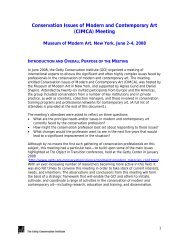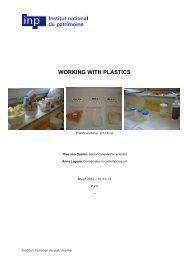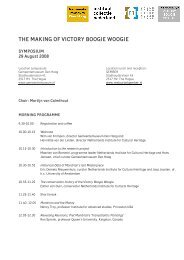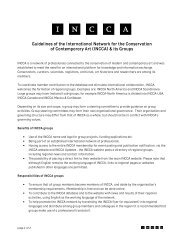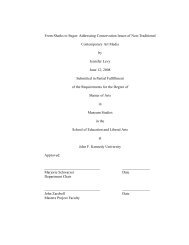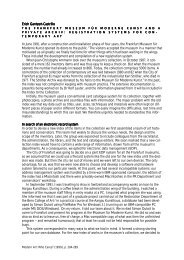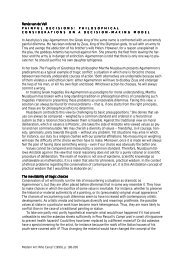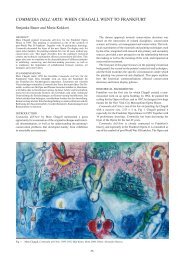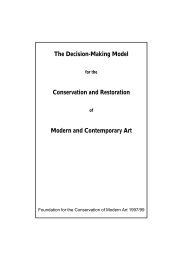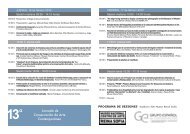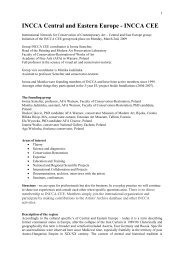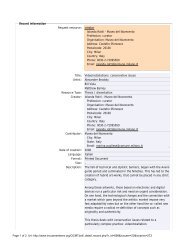Installations and problems of preservation.pdf - incca
Installations and problems of preservation.pdf - incca
Installations and problems of preservation.pdf - incca
You also want an ePaper? Increase the reach of your titles
YUMPU automatically turns print PDFs into web optimized ePapers that Google loves.
A scheme for documen<br />
menta<br />
tation<br />
tion<br />
These few examples present different scenarios, each with its own set <strong>of</strong> criteria. They reflect a<br />
range <strong>of</strong> potential issues <strong>and</strong> raise important questions to ponder when confronted with similar<br />
works. One common thread linking all <strong>of</strong> these examples is that careful documentation is the key to<br />
the interpretation <strong>and</strong> decision-making process for the future. Time can blur the most crystal-clear<br />
idea. Quite common is the tendency to apply contemporary sensibilities to historical objects; as<br />
these works become more planted in the history <strong>of</strong> art, there will be a tendency towards revisionism<br />
<strong>and</strong> skewed perceptions.<br />
The issues <strong>and</strong> questions raised by these examples can also be applied to more contemporary<br />
works which include electronics or computer generated images. Al-though each object will have its<br />
own concerns, the philosophical basis for discussing the museum’s role as caretaker remains the<br />
same: how do we best serve the art? This may be by maintaining <strong>and</strong> storing the materials in their<br />
present state, or by transferring images or information to a more stable electronic form, or by deriving<br />
a plan for replacement <strong>of</strong> obsolete technology in conjunction with the artist. 9 In all cases, accurate<br />
information about the intent <strong>of</strong> the piece is a prerequisite. Working with colleagues in other<br />
disciplines – art historians, technicians, registrars, industrial scientists, fabricators – is necessary<br />
for a holistic underst<strong>and</strong>ing <strong>of</strong> the pieces <strong>and</strong> to foresee pitfalls.<br />
Thus, it is essential to set up a scheme for documentation <strong>and</strong> to produce a thorough document<br />
when the original piece is constructed. Every work will have its own requirements, so the outline<br />
cannot be too rigid. It should be kept in mind that the inherent nature <strong>of</strong> creativity defies our obsessive<br />
need to categorise <strong>and</strong> catalogue. Acknowledging this, the following outline can serve as a<br />
guide for those <strong>of</strong> us who have the responsibility for seeing these installation works into the future:<br />
1. Photo-documentation <strong>of</strong> all stages <strong>of</strong> the process <strong>and</strong>, if applicable, video <strong>and</strong> sound documentation.<br />
2. Complete notes <strong>and</strong> documentation for the initial development stage.<br />
This is <strong>of</strong>ten crucial in the underst<strong>and</strong>ing <strong>of</strong> why certain things were done. Many times compromises<br />
are made during installations due to cost factors, time restrictions <strong>and</strong> limited availability <strong>of</strong><br />
materials. Knowing the history behind certain decisions makes the reinstallation <strong>of</strong> a work much<br />
easier. Within any institution, it is quite difficult to establish a methodology for recording these<br />
decisions. They are <strong>of</strong>ten made during informal conversations or during last-minute installations<br />
<strong>and</strong> do not get passed along. The appointment <strong>of</strong> a documentation coordinator would facilitate this<br />
process – he/she keeping up with the work, asking questions about any decisions taken <strong>and</strong><br />
attempting to underst<strong>and</strong> what the concept is as it unfolds.<br />
3. Coordination between the curator, registrar, conservators, technicians <strong>and</strong> lighting specialists in<br />
order to underst<strong>and</strong> the ‘whole’ installation.<br />
In this way uninformed <strong>and</strong> inappropriate decisions can be avoided as much as possible.<br />
4. Solicitation <strong>of</strong> reports from all participants in the project.<br />
This would include technicians, curatorial representatives, curators, registrars, lighting consultants,<br />
electricians, etcetera. These reports would be collected <strong>and</strong> reviewed by the documentation coordinator,<br />
citing all inconsistencies.<br />
5. Central archive to file reports.<br />
Easy access in the event that the piece needs to be refabricated. This reduces the possibility that<br />
individual files will be lost <strong>and</strong> that personnel changes within the institution cause loss <strong>of</strong> valuable<br />
information.<br />
6. Interview with the artist.<br />
It is ideal if the artist can be persuaded to focus on the banal aspect <strong>of</strong> documentation at some<br />
time close to the installation <strong>of</strong> the original work. In that way artists are able to give an accurate<br />
Modern Art: Who Cares? (1999), p. 272-281



